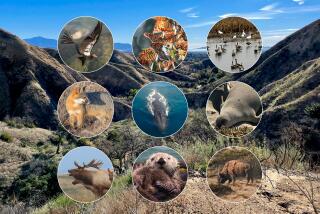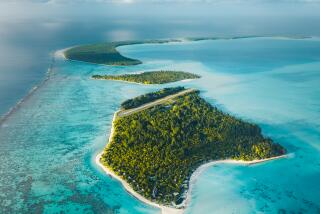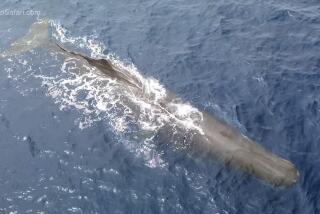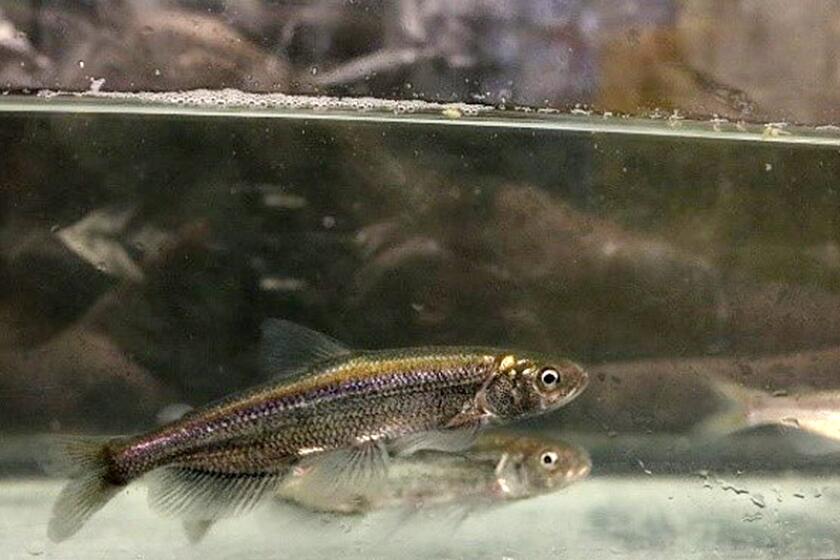New Zealand’s Natural Playground of Sea Life : Visitors to this village north of Christchurch can sight sperm whales and swim with dolphins.
- Share via
KAIKOURA, New Zealand — Except for our headlights that quiver before us, the world outside the car is black. The midnight stars, usually such benevolent companions on New Zealand’s South Island, lie trapped behind the creeping clouds.
All we know of the gravel road as it twists and falls from Christchurch toward Kaikoura comes from a map: The mangled trees and unforgiving bluffs to our left mark the end of miles of rugged mountains and forests, and the dark void to our right the start of a sheer, rocky descent to the Pacific.
This is my second trip to Kaikoura, a small east coast fishing village about 115 miles north of Christchurch. The first was two years ago. I’ve seen much of New Zealand since, having traveled twice from its top to its tail.
But now, even in the inhospitable night, it’s easy to remember what’s so alluring about Kaikoura: a chance to glimpse the elusive sperm whales feeding a few miles offshore, to swim and play in the same Pacific waters with hundreds of dusky dolphins, the species of dolphin prevalent in these waters, and to watch colonies of fur seals sunbathe along the rocky coast.
This isn’t a man-made aquarium of captive animals, but a refreshingly unkempt mecca of marine life in the wild, where encounters are left to chance and the entire scene is dwarfed by the brooding, snow-topped Kaikoura Mountains and a sprawling tableau of forests and farms.
Kaikoura, which means a “feast of crayfish” in Maori, presents all the signs of a fishing village. Weathered fishing boats drift near an aging wharf and a bustling fishery swarming with gulls. Cottages and boathouses dot the coastline. “Crayfish” signs hang on storefronts and dilapidated trucks astride the highways out of town.
But the sign that’s meant the most to the area’s 3,000 residents in recent years belongs to Nature Watch, the first, and more visible, of the two whale-watch operations that started here five years ago.
It’s windy and cold the next morning as my wife and I step inside the office on Kaikoura’s main street to pick up our tickets for a three-hour whale-watching trip aboard a 12-seat Zodiac.
We pay $48 each and peruse the rate chart as though it were a racetrack tote board. There’s an 80%-95% chance of a whale sighting, except in September when the odds drop to 50-50. Our chance on this summer’s day is listed as 80%. But we don’t count on anything. We came up empty with the same odds two years ago.
The search for the elusive sperm whales takes us several miles out to sea to an area where more than 100 years ago Kaikoura’s first European settlers hunted whales with harpoons. Several minutes later, the first sign of the whales comes from the boat’s underwater microphone which picks up the loud clicks whales use for echolocation, their natural sonar.
“They’re underneath us,” our guide tells the 12 of us crowded in the powerful rubber boat. “We just have to wait for them to surface. Keep an eye on the water for their spouts.”
As we watch and wait, the guide fills us with facts about the sperm whales. They’re drawn to the Kaikoura area, he tells us, because New Zealand’s continental shelf is narrowest here, the bottom plunging to more than 23,000 feet just three miles from the coast. These warm coastal waters support an array of food, like giant squid, that the young male sperm whales in particular--at average lengths of 45 feet--come in closer to shore to eat.
The seas are swelling now; the sun’s all but gone. There’s nothing in the steel-blue sea except for a few albatrosses bobbing in the pitch and sway on nine-foot swells. I try to focus on a gull flying stiffly across the horizon, but I’m starting to feel sick.
“There! Over there!” someone shouts, pointing at a spray of water behind the boat.
I turn to see the back of a sperm whale, black and ominous, sliding effortlessly and graciously through the water’s surface. I’m hoping, after two trips to Kaikoura, that there’s more to see, but then it’s gone, its tail flukes pointing at the sky in a final flourish.
Our eyes hunt the sea for more spouts. We spot two more sperm whales in the distance before the rough seas force the boat back to shore, leaving us with a tiny disappointing look at the Earth’s largest toothed whale. “Was this a good sighting?” I ask the driver. “No, not at all, we usually get much better views,” he says.
There’s nothing elusive about the marine life we discover the next day. The morning breaks without a cloud and drenches us with sun as we walk along the Kaikoura Peninsula’s South Bay. It’s low tide and we climb over ragged reefs. The sparkling blue water is calm as it washes over the rocky shallows.
First we meet red-billed gulls, thousands of them bustling in a breeding colony atop a sprawl of rocks. The females nest among pink-flowered vegetation clinging to the rocks; the males parade and preen at the perimeter. They’re a strident bunch, pressuring us to move on with their squawks. We laugh, like parents scorned by a mimicking child, but we move on.
A few feet away we find a fur seal sunbathing on a rock. Languid and sensual, he lies on his back, head upside down and staring at us with big, brown eyes.
We sit about 10 feet away to watch him. His body shakes in comic quivers as he wriggles on the rock’s rough edges to soothe an itch. He fans himself with casual waves of his black flipper, the rest motionless except his eyes which follow our every move.
The next fur seal on our path stops us in our tracks with his bellows and grunts as he lies resting in a small passage to the other side of the bay. He might let us pass, but I don’t want to risk it. These blubbery creatures move with surprising speed and are especially dangerous when something stands between them and the water.
The next morning we gather at the center where Dolphin Encounters starts its trips, to prepare for our dolphin swim. We and eight others don wetsuits and pick up snorkeling gear for the three-hour, $43-trip, guided by fisherman Rick Buurman. Buurman and Ian Bradshaw started the dolphin charter on a casual basis in 1989, but it’s since become a full-fledged business.
Dolphin swimming has created controversy in other parts of the world, particularly in the Caribbean, where conservationists fear that the growing numbers of people attempting to swim with dolphins amounts to harassment of these intelligent sea mammals and may have long-term adverse affects on their behavior. But there’s been no such controversy in Kaikoura and conservation-driven New Zealand, according to Andrew Baxter, a New Zealand conservation officer.
The three commercial boats licensed for dolphin swimming restrict the number of swimmers to 15 per dolphin pod, and local regulations limit boat speed and noise levels in dolphin areas and anything else that would harass the dolphins, Baxter said. Also, Kaikoura’s wild, sparsely populated coast and rough weather conditions keep recreational boats in the area to a minimum. “We don’t have much of a problem because we don’t have anywhere near the number of people swimming here that you see in other areas of the world,” Baxter said. He added that he knows of no instance in Kaikoura where a human has been injured by a dolphin.
It takes about 15 minutes in the fishing boat to find them, a school of about 100 slicing and jumping through the water. As the boat moves alongside them, the driver gives our group instructions.
“Wait for the boat to stop and then jump in quickly or they’ll be gone,” he says.
After the boat stops, only a few of us go right in. The dolphins seem to be gone as I swim aimlessly near the boat. I pull my head out of the water to watch several breaching and flipping through the air. I stick my face under again and swim, splashing to draw their attention. It works. One speeds toward me, then two more. They get within five feet of my face, then dart away.
I feel as if I’ve been dropped in a tank invisible to them because they’re coming so close, so trusting. I turn to my left to face four more bearing down on me. They weave together in a ballet of porpoising--their propulsive device of bobs and bends. I reach out. They duck under me and just beyond my grasp.
By the time the boat’s horn blows and we get back to it in order to catch up to the school, we’re all abuzz with what we’ve seen. These 6-foot creatures with two-toned dorsal fins and rounded snouts are powerful beings, reaching speeds of 30 m.p.h. and capable of killing a person with a single strike. But all anyone can talk about is how gentle and playful they are. We left Kaikoura not long after our swim with the dolphins. We left on the same road we drove in on, transformed now by a bright afternoon sun: an expanse of rugged mountains and forests to our right and to our left, as far as the eye could see, the vacant, shimmering Pacific.
GUIDEBOOK
South Island Sightings
Getting there: From Christchurch, drive north on Highway 1 about 115 miles to Kaikoura. Rail and bus are also available.
Whale-watching: Kaikoura whale-watch excursions run 12 months a year, but the chance of seeing whales is better during the warmer months, October-March. Reservations are recommended, particularly December-January. For whale-watch charters: Nature Watch and Kaikoura Tours, P.O. Box 89, Kaikoura, New Zealand; telephone 011-64-3-319-5045 from the U.S.
Dolphin swims: Dolphin Encounters, 58 West End, Kaikoura; 011-64-3-319-6777. Also, New Zealand Sea Adventures, P.O. Box 85, Kaikoura; 011-64-3-319-6622.
Where to stay: Kaikoura offers camping and camper facilities and backpackers’ hostels from under $10 a night. The town also has nine modest motels, all priced under $50 per room. More specific information can be obtained from the Kaikoura Information Center, Esplanade Road, Kaikoura; 011-64-3-319-5641.
For more information: Contact the New Zealand Tourism Board, 501 Santa Monica Blvd., Suite 300, Santa Monica 90401, (800) 388-5494 or (310) 395-7480.
More to Read
Sign up for The Wild
We’ll help you find the best places to hike, bike and run, as well as the perfect silent spots for meditation and yoga.
You may occasionally receive promotional content from the Los Angeles Times.






